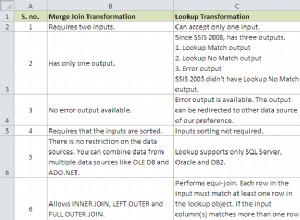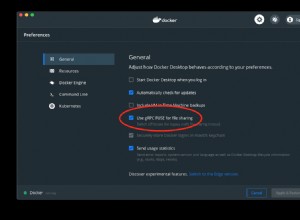Il modo per farlo è con un UNPIVOT. Ecco la soluzione:
With AddrTable as (
Select AddrFld, MailAddr From (
Select Cast(ISNULL([Line1], '') as Varchar(102)) as [A1],
Cast(ISNULL([Line2], '') as Varchar(102)) as [A2],
Cast(ISNULL([Line3], '') as Varchar(102)) as [A3],
Cast(ISNULL(LTRIM(RTRIM(City)),'') + ' ' + ISNULL(LTRIM(RTRIM(RegionCode)),'') + ' ' + ISNULL(LTRIM(RTRIM(PostalCode)),'') as Varchar(102)) as A4
From TableName Where [email protected]) p
Unpivot (MailAddr For AddrFld in ([A1], [A2], [A3], [A4])) as unpvt)
Select Row_Number() over (Order by (Case Len(MailAddr) When 0 then 1 else 0 end), AddrFld) as RN,
MailAddr From AddrTable
Order By RN
Ecco l'output:
Address1
Westby WI 55555
-empty line-
-empty line-
Nota che ho dovuto usare "Varchar(102)" come lunghezza del campo (unpivot richiede che tutti i campi siano gli stessi) perché la tua città/regione/postale può avere fino a 102 caratteri in totale. Inoltre, tieni presente che "@UniqueID" è l'identificatore del record di cui hai bisogno dell'indirizzo. Questo restituisce quattro e sempre quattro righe contenente i dati di cui hai bisogno per il tuo indirizzo.
AGGIORNAMENTO: Se è necessario restituirlo come un insieme di quattro colonne anziché quattro righe, quindi inseriscilo in una vista e quindi interroga la vista con un Pivot . Ho incluso la vista qui per completezza poiché ho dovuto modificare leggermente quanto sopra durante la creazione della vista in modo che il campo uniqueID fosse incluso e non fosse stato eseguito alcun ordinamento (l'ordinamento ora è eseguito nella query):
Create View AddressRows AS
With AddrTable as (
Select UniqueID, AddrFld, MailAddr From (
Select UniqueID,
Cast(ISNULL([Line1], '') as Varchar(102)) as [A1],
Cast(ISNULL([Line2], '') as Varchar(102)) as [A2],
Cast(ISNULL([Line3], '') as Varchar(102)) as [A3],
Cast(ISNULL(LTRIM(RTRIM(City)),'') + ' ' + ISNULL(LTRIM(RTRIM(RegionCode)),'') + ' ' + ISNULL(LTRIM(RTRIM(PostalCode)),'') as Varchar(102)) as A4
From TableName Where [email protected]) p
Unpivot (MailAddr For AddrFld in ([A1], [A2], [A3], [A4])) as unpvt)
Select UniqueID,
Row_Number() over (Order by (Case Len(MailAddr) When 0 then 1 else 0 end), AddrFld) as RN,
MailAddr From AddrTable
E poi, quando vuoi estrarre la tua "riga" corrispondente, ruotala indietro usando questo SQL (nota che sto interrogando di nuovo usando UniqueID):
Select [Addr1], [Addr2], [Addr3], [Addr4] From (
Select Top 4 'Addr' + Cast(Row_Number() over (Order by RN) as Varchar(12)) as AddrCol, -- "Top 4" needed so we can sneak the "Order By" in
MailAddr
From AddressRows Where [email protected]
) p PIVOT (Max([MailAddr]) for AddrCol in ([Addr1], [Addr2], [Addr3], [Addr4])
) as pvt
Questo restituisce:
Addr1 Addr2 Addr3 Addr4
-------------- ------------------ ------------- ------------------
Address1 Westby WI 54667




